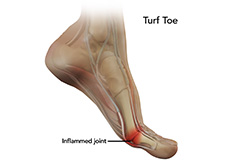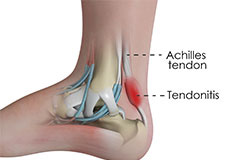
Achilles Tendinitis
The Achilles tendon is the largest and strongest tendon in the body. It connects the calf muscles to your heel bone, providing the power to walk, run, climb stairs, jump, and stand on tiptoes. Achilles tendonitis is a general term that describes inflammation of the tendon, causing pain.
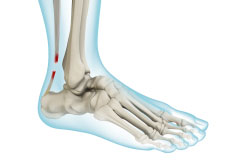
Achilles Tendon Rupture
The Achilles tendon is the largest and strongest tendon in the human body. It connects the calf muscles (gastrocnemius and soleus) to the heel (calcaneus).
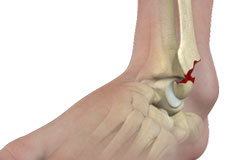
Ankle Fractures
Ankle injuries are very common in athletes and individuals performing physical work; often resulting in severe pain and impaired mobility. Pain after ankle injuries can either be from a torn ligament (ankle sprain) or broken bone (ankle fracture).
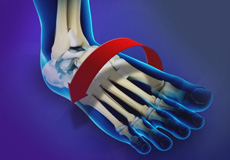
Ankle Instability
The joints of the ankle are held in place and stabilized by strong bands of tissue called ligaments. Ankle instability is a chronic condition characterized by a recurrent slipping of the outer side of the ankle.
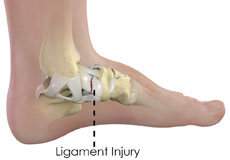
Ankle Ligament Injury
An ankle ligament injury, also known as an ankle sprain, can be caused by a sudden twisting movement of the foot during any athletic event or during daily activities. When stretched beyond its limit, the ligament may partially or completely tear.
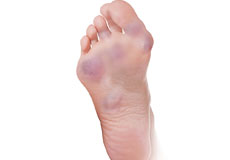
Ankle Rheumatoid Arthritis
Arthritis is inflammation in a joint as a result of cartilage degeneration causing joint pain, swelling, stiffness, and restricted movement. Arthritis of the foot and ankle joint can occur due to fractures, dislocation, inflammatory disease, or congenital deformity.
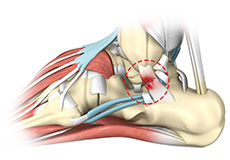
Ankle Sprains & Instability
An ankle sprain is one of the most common injuries around the foot and ankle. ‘Sprain’ refers to stretching of the ligaments that provide stability to the ankle. Different mechanisms of injury include an ‘inversion’ injury when the ankle rolls inside, ‘eversion’ injury when it rolls outside or a twisting injury as shown in the illustration below.
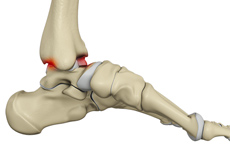
Anterior Ankle Impingement
This is a common cause of pain at the front of the ankle joint. ‘Impingement’ describes the presence of excess bone or soft tissue within the ankle that causes bumpering shin bone and ankle bone.
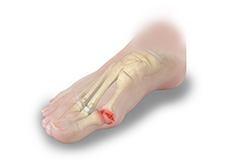
Big Toe Arthritis
Arthritis refers to ‘wear and tear’ of a joint. This may occur at the base of the big toe. A common medical term for this condition is ‘hallux rigidus’, Latin for ‘stiff big toe’. The exact cause is unknown but is associated with those who are active, or have suffered gout, or other inflammatory conditions such as rheumatoid disease.

Bunion
A bunion is a bony protuberance that appears on the outer surface of the big toe when it angles toward the adjacent toe. It is an extra bone and a fluid-filled sac that grows at the base of the big toe.
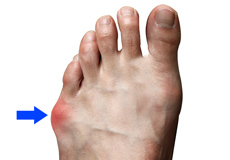
Bunionette
Bunionette also referred to as a tailor’s bunion is a bony lump that grows on the outside of the foot at the base of your little toe. The deformity got its name as q tailor’s bunion when tailors once sat with their legs crossed all day, with the outside edge of their feet rubbing on the ground.

Bunionette (Tailor's Bunion)
Bunionette, also called Tailor’s bunion, is a bony lump formed along the outside of the little toe at the base. It occurs when the very bottom bone (fifth metatarsal bone) of the little toe enlarges or shifts outward.
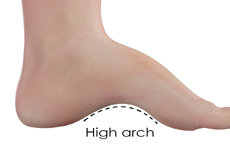
Cavus Foot Deformity
Cavus foot also referred to as a high arch, is a condition in which the arch on the bottom of the foot that runs from the toes to the heel is arched more than normal. Because of this, excessive weight falls on the ball and heel of the foot when walking or standing, causing pain and instability.
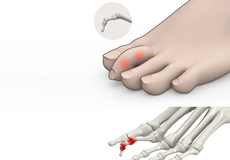
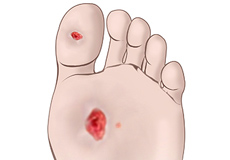
Diabetic Foot Conditions
Diabetes is a chronic condition that is characterised by high blood glucose (sugar) levels. Diabetic patients are at high risk for developing chronic wounds, especially in the feet.
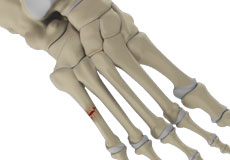
Fifth Metatarsal Fractures
The metatarsal bones are the long bones in your feet. There are five metatarsal bones in each foot. The fifth metatarsal is the long bone that is located on the outside of the foot and connects to the small toe.
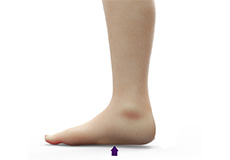
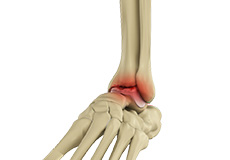
Foot and Ankle Arthritis
Arthritis is the inflammation of joints as a result of degeneration of the smooth cartilage that lines the ends of bones in a joint. This degeneration of the cartilages leads to painful rubbing of the bones, swelling, and stiffness in the joints, resulting in restricted movements.
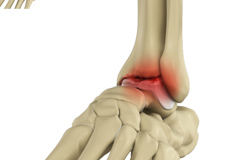
Foot and Ankle Osteotomy
Foot and ankle osteotomy is a surgery performed to remove parts of a bone in your foot or ankle that might be causing pain or limiting your mobility. The surgery helps relieve pressure on the foot and ankle caused by the bone deformity or injury.
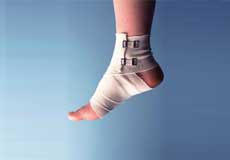
Foot and Ankle Trauma
Foot and ankle trauma refers to injuries that most commonly occur during sports, exercise or any other physical activity. Trauma may be a result of accidents, poor training practices or use of improper gear.
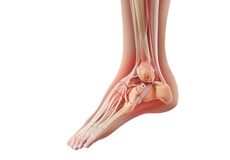
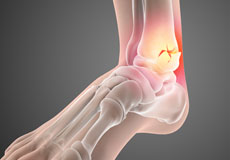
Foot Fracture
Trauma and repeated stress can cause fractures in the foot. Extreme force is required to fracture the bones in the hindfoot. The most common type of foot fracture is a stress fracture that occurs when repeated activities produce small cracks in the bones.
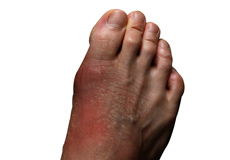
Foot Infections
Foot infections may occur after trauma to the foot or loss of tissue because of contamination from foreign material and/or bacteria or fungus. Infections can occur in healthy individuals as well as in those whose health is compromised.
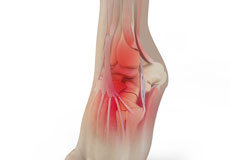

Foot Problems
The foot is a highly complex part of the human body that has an integral role in most activities of daily living. It consists of 26 bones connected with joints, ligaments, and tendons.

Foot Rheumatoid Arthritis
Arthritis is inflammation in the joint resulting from the degeneration of cartilage causing joint pain, swelling, and stiffness resulting in restricted movements. Arthritis of the foot and ankle joint can occur due to fractures, dislocation, inflammatory disease, or congenital deformity.
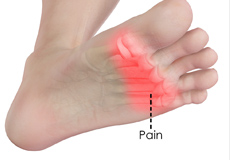
Forefoot Pain
Forefoot pain, also referred to as metatarsalgia, is a type of pain that occurs in the ball of the foot (along the ends of the metatarsal bones). Generally, forefoot pain is associated with aging.

Freiberg's Disease
Freiberg’s disease, also known as Freiberg infraction, is a condition characterized by avascular necrosis (death of bone tissue due to lack of blood supply) mostly in the second or third metatarsal bones located at the base of the second and third toes of the feet.
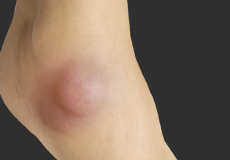
Ganglion and Soft Tissue Tumours
A ganglion is a round, sac-like swelling or a fluid-filled lump under the skin near your foot and ankle joint. It can become bigger or smaller over time and may be visible or not, especially if it is small.
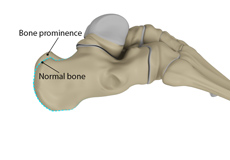
Haglunds Deformity
Haglund’s deformity, also known as “pump bump”, is a condition in which bony extensions are formed at the back of the heel, leading to swelling near the Achilles tendon.
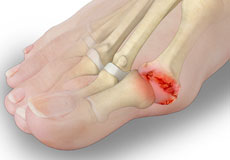
Hallux Rigiditis
Hallux Rigiditis is a form of degenerative arthritis at the metatarsophalangeal or MTP joint where the base of your big toe attaches to the foot. Arthritis is the inflammation of joints as a result of degeneration of the smooth cartilage that lines the ends of bones in a joint.
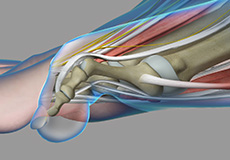
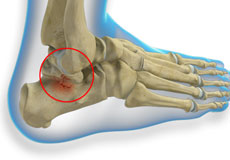
Heel Fractures
The calcaneus or heel bone is a large bone found at the rear of the foot. A heel fracture is a break in the heel bone due to trauma or various disease conditions.

Heel Pain
Heel pain is a common symptom of excessive strain placed on the structures that form the heel. The heel is made up of the calcaneus bone and supported by a network of muscles, tendons, ligaments and soft tissues, which together support the weight of the body and stress during movement.
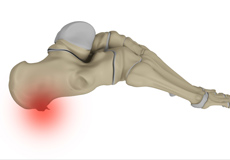
Heel Spurs
The heel is made up of the calcaneus bone and supported by a network of muscles, tendons, ligaments and soft tissues, which together support the weight of the body and stress during movement.

Ingrown toenail
Ingrown toenails may lead to pain and redness, and most commonly involve the big toe. An ingrown toenail may become locally infected with a pus discharge and require several courses of antibiotics before settling.
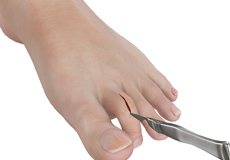
Lesser Toe Deformities
Lesser toe deformity is an abnormality in the anatomy of your toe that occurs as a result of imbalance between the intrinsic and extrinsic muscles.
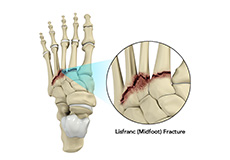
Lisfranc (Midfoot) Fracture
The Lisfranc joint or tarsometatarsal joint refers to the region in the middle of the foot. It is a junction between the tarsal bones (bones in the foot arch) and metatarsal bones (five long bones in the foot).

Lisfranc (Midfoot) Injury
The Lisfranc joint is found at the base of the first and second metatarsal bones, in the middle of the foot. A strong ligament, known as the Lisfranc ligament, spans across the joint.
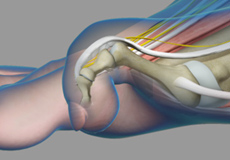
Mallet Toe
Mallet toe is a deformity where the toe abnormally bends downward, resembling a hammer or mallet. The bones at the tip of the toe are connected by the distal interphalangeal joint (DIP).
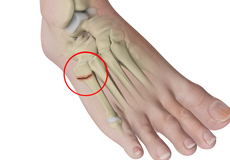
Metatarsal and Phalangeal (Forefoot) Fractures
The forefoot is the anterior or front portion of the foot that functions in weight-bearing and maintaining balance while standing, walking or running. It is formed by 5 metatarsal bones, 14 phalange bones, and various soft tissues.
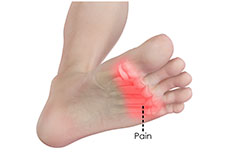
Metatarsalgia
Metatarsalgia is a condition in which pain and inflammation are caused due to overuse or injury to the ball of the foot - the area between the toes and the arch. This condition mainly affects the joints at the base of the five-toe bones.
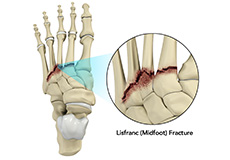
Midfoot Arthritis
Midfoot arthritis is pain and inflammation of the midfoot. It occurs due to damage of cartilage or tissues around the joints. The damage may occur due to injury, ageing or autoimmunity.
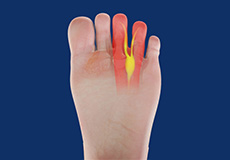
Morton's Neuroma
This is a painful benign swelling or irritation of the digital nerve that runs between the metatarsal bones of the foot. Entrapment of this nerve causes pain in the ball of the foot that radiates to the toes and is sometimes described as feeling like walking on a pebble or marble.
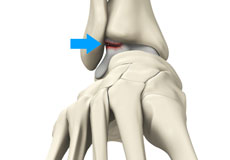
Osteochondral Injuries of the Ankle
The ankle joint is formed by the articulation of the end of the tibia and fibula (shinbones) with the talus (heel bone). Osteochondral injuries, also called osteochondritis dissecans, are injuries to the talus bone.
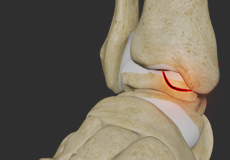
Osteochondral Lesions of the Ankle
The posterior tibial tendon passes through the ankle to attach the calf muscle with the bones of the midfoot. It provides stability to the arch and supports the foot while walking.
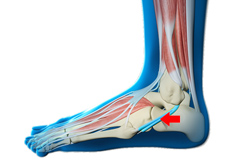
Peroneal Tendon Dislocation
The peroneal tendons run behind the lateral malleolus (the bony protrusion on the outside of the ankle). They connect the peroneal muscles - the peroneus brevis and peroneus longus - to the foot.
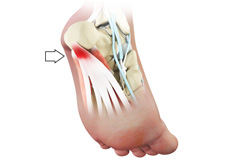
Plantar Fasciitis
Plantar fasciitis is one of the most common causes of heel pain. It can affect both active and sedentary individuals. The plantar fascia is a thick band of tissue under the skin of the sole of the foot.
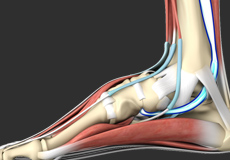
Posterior Tibial Tendon Dysfunction
The posterior tibial tendon passes through the ankle to attach the calf muscle with the bones of the midfoot. It provides stability to the arch and supports the foot while walking.
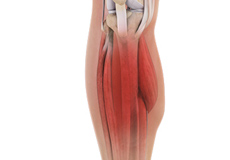
Shin Splints
Shin splints or medial tibial stress syndrome (MTSS) is pain around the tibia or shinbone due to inflammation of the tendons, muscles and bone tissue. It occurs because of vigorous exercises and sports activities.

Stiff Big Toe (Hallux Rigidus)
A stiff big toe, also called hallux rigidus, is a form of degenerative arthritis affecting the joint where the big toe (hallux) attaches to the foot. The toe typically becomes stiff at the base and is sometimes called a “frozen joint”.
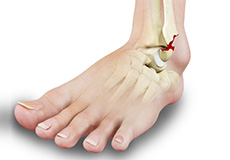
Stress Fractures of Foot and Ankle
A stress fracture is a small hairline crack or break typically seen in weight bearing bones, such as in the leg bone (called the tibia) or in the foot.
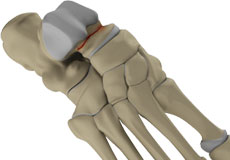
Talus Fractures
The talus is a small bone at the ankle joint that connects the heel bone and the shinbones, enabling up and down movement of the foot.
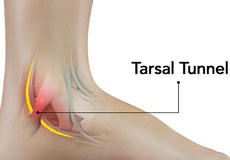
Tarsal Tunnel Syndrome
The tarsal tunnel is a narrow passageway that lies on the inside of your ankle and runs into the foot. It encloses arteries, veins, tendons and nerves that supply the foot.
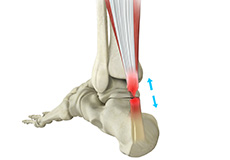
Achilles Tendon Repair
Tendons are the soft tissues connecting muscle to bone. The Achilles tendon is the longest tendon in the body and is present behind the ankle, joining the calf muscles with the heel bone. Contraction of the calf muscles tightens the Achilles tendon and pulls the heel, enabling the foot and toe movements necessary for walking, running and jumping.
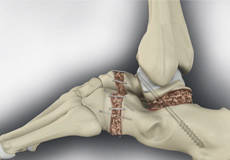
Ankle Arthrodesis
Ankle arthrodesis, commonly referred to as ankle fusion, is a surgical procedure employed for the treatment of ankle arthritis.
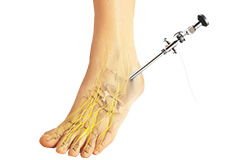
Ankle Arthroscopy
Ankle arthroscopy is key-hole surgery or minimally invasive surgery into the ankle joint using a small camera called an ‘arthroscope’. This allows Mr Davda to visualise the entire ankle joint and treat a variety of conditions.
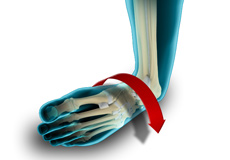
Ankle Instability Surgery
Ankle instability is a chronic condition characterized by the recurrent slipping of the outer side of the ankle. Instability is generally noticed during movement of the ankle joint, but can also occur while standing.
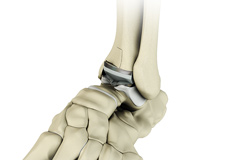
Ankle Joint Replacement
Ankle joint replacement, also known as total ankle arthroplasty, is a surgical procedure performed to relieve pain and immobility due to severe end-stage arthritis that has not responded to non-surgical treatments. The goal of ankle joint replacement surgery is to eliminate your pain and increase the mobility of your ankle joint.
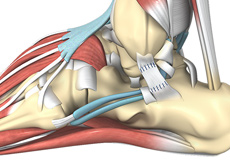
Ankle Ligament Reconstruction
Ankle ligament reconstruction may be performed arthroscopically under general anaesthesia. Your surgeon will make small incisions in your ankle. A tiny camera and a few special instruments are inserted through the incisions to repair and strengthen the ligaments. Stretched or torn ligaments will be shortened and stitched as needed.
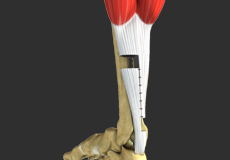
Ankle Tenotomy
Ankle tenotomy is a surgical procedure to lengthen the Achilles tendon, enabling the ankle to flex upward and allowing the heel to be placed flat on the floor. It is indicated in if you have an abnormally developed Achilles tendon or one that has become shortened and is difficult to stretch.

Brostrom Repair
Brostrom repair is a surgical procedure that involves the repair and reconstruction of injured ligaments on the outside of the ankle to treat ankle instability. The two ligaments of the ankle that are commonly injured are the anterior talofibular ligament (ATFL) and the calcaneofibular ligament (CFL).
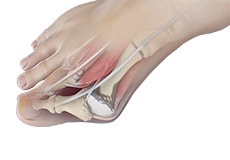
Bunionectomy
A bunionectomy is a surgical procedure to remove a bunion. A bunion, also called a hallux valgus, is an enlargement of bone or soft tissues around the joint at the base of the big toe that results in the formation of a bump.

Cavovarus Foot Correction
To support the entire body’s weight on your two feet, the inner middle portion of each foot (midfoot) is raised off the ground to form an arch. A cavovarus foot deformity is characterized by a higher-than-normal arch of the inner midfoot.
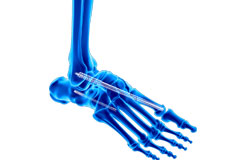
Charcot Reconstruction
Charcot foot and ankle is a condition characterised by gradual weakening of the bones, joints and soft tissues, and loss of sensation in the foot and ankle. It is caused by nerve damage (neuropathy) in the foot and ankle or due to diabetes.
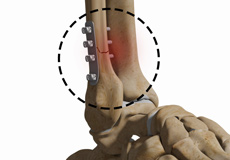
Complex Foot and Ankle Surgeries
Complex foot and ankle surgeries are procedures employed to treat foot and ankle structures with deformities, injuries, structural issues, and damage from diseases like diabetes or arthritis.

Corrective and Prescription Shoes
The feet are the only parts of the body that bear its entire weight and are involved in most physical activities. Wearing poor-fitting shoes can cause calluses, bunions, corns, hammer toe, cracks, infections, and even traumatic injuries.
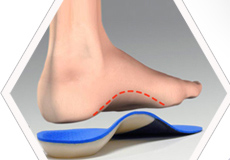
Custom Inserts
Custom inserts are specially designed and highly customized shoe inserts a doctor will prescribe to treat certain conditions of the foot. Also called “insoles or foot orthotics”, they are made specifically for you to wear inside your shoes to correct biomechanical problems of your foot or heel.

Cyst Removal
A cyst is a small irregular, non-cancerous sac-like structure filled with fluid or pus. It may be found in any part of the body including the foot. Cysts are caused due to infection, trauma, or blocked oil glands. They usually grow slowly and have a smooth surface.

Flatfoot Reconstruction
Foot reconstruction is a surgery performed to correct the structures of the foot and restore the natural functionality of the foot that has been lost due to injury or illness.
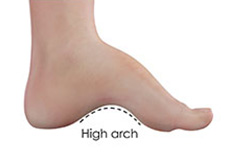
Foot & Ankle Deformity Correction
Foot and ankle deformity is the structural abnormality caused by misalignment of the bones of the foot and ankle.

Foot and Ankle Examination
Foot and Ankle conditions typically occur due to injury of the muscles, ligaments or bones, due to ageing, or certain disorders including gout, bunion, arthritis, claw toes, bursitis, hammertoes, stress fracture, etc.
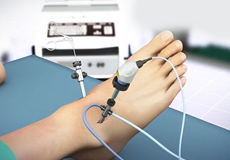
Foot and Ankle Orthopaedic Surgeon
Coming soon
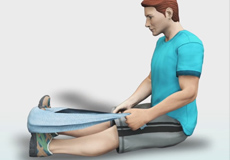
Foot and Ankle Rehabilitation
The foot is composed of different structures including bones, ligaments, tendons, and muscles. As the feet bear the weight of our body, they are more prone to injury and pain. A foot injury or foot surgery may leave you immobile for a period of time.

Foot Rehabilitation Following Surgery
A good exercise program to rehabilitate foot and ankle conditions focuses on strengthening and stretching the muscles and tendons of the lower leg, feet, and ankles to relieve pain and soreness, keep the muscles flexible, provide stability and prevent future injury.

Great Toe Replacement with Synthetic Cartilage
Great toe replacement with synthetiic cartilage is a surgical procedure for the treatment of great toe arthritis in which damaged sections of the great toe joint are removed and replaced with an artificial component (synthetic cartilage implant).
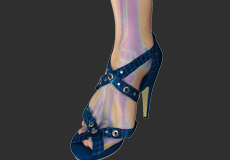
High Heels
High heels have been worn by many women for years to look taller and nowadays they are commonly worn as part of a fashion statement. Women wearing high heels appear taller with longer legs; however, this causes postural changes which bring a host of health issues when high heels are worn too frequently.
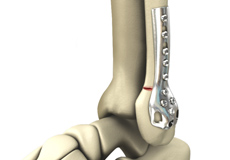
Internal and External Fixation of Foot and Ankle Fractures
Foot and ankle fractures are breaks or cracks in any bone of your foot and ankle joint. Fixation of fractures is a surgical method of reconnecting the broken or cracked bones and fixing them in the correct place using orthopaedic hardware.

Joint Injections In The Foot and Ankle
The foot and ankle is a complex structure composed of many joints and soft tissues. Injections can help pinpoint which is causing your symptoms.

Lesser Toe Surgery
Lesser toe surgery is an operation to correct deformities of the lesser toes other than the big toe. Some of the common lesser toe deformities include hammer toe, claw toe, and mallet toe.

Metatarsal Surgery
Metatarsal surgery is a surgical procedure performed on the metatarsal bones, the long bones in the feet that connect to the toe bones. It is usually performed to correct a bunion deformity and is mainly done on the first metatarsal bone behind the big toe.
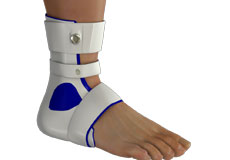
Non-Surgical Treatment for Foot and Ankle Pain
Coming soon

Pregnancy and Your Feet
Pregnancy causes many changes in a woman’s body such as hormonal fluctuations, increased body weight, and shifting of the centre of gravity.

Removal of Metalwork
Metalwork that has been used to treat a broken bone or an elective condition such as arthritis does not normally require removal. It is safe inside the body and causes no long term side effects.
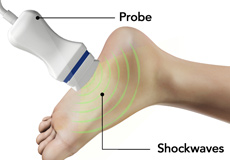
Shockwave Therapy
Extra-corporeal Shock Wave Therapy (ESWT) is a non invasive procedure carried out within a clinic setting and requires no injections or medication, and provides an alternative to surgery.

Shockwave Treatment for Plantar Fasciitis
Shockwave treatment, also known as Extracorporeal Shock Wave Therapy (ESWT), is a conservative procedure to treat plantar fasciitis of the foot, where shockwaves are passed through the heel to stimulate healing of the inflamed plantar fascia tissues.
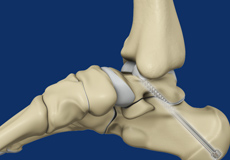
Subtalar Arthrodesis
The subtalar joint is a complex joint located below the ankle joint and is formed by the union of the heel (calcaneus) and the talus (ankle) bone. The subtalar joint allows side-to-side movement of the foot.
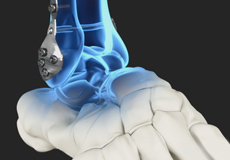
Syndesmosis with TightRope Fixation
The ankle is made up of the tibia and fibula bones of the lower leg, and the tarsus bone of the foot. They are held together by ligaments, which provide strength and stability during movement.
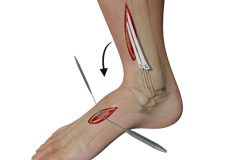
Tendon Transfer
In a tendon transfer procedure, a healthy tendon is transferred to replace the damaged tendon and restore the normal movement of the foot.

Toe Exercises
Toe exercises improve foot flexibility and strength and can help alleviate muscle soreness caused by the stress exerted on the foot each day. Healthy toes also improve your balance and reduce your risk of falls.
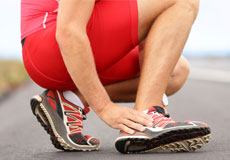
Treatment of Foot and Ankle Sports Injuries
Injuries during sports are common. They can result from accidents, inadequate training, improper use of protective devices, or insufficient stretching or warm-up exercises. Injuries to the foot and ankle are common while playing sports such as football, hockey, skating and in weekend athletes.
What is the Normal Anatomy of the Foot and Ankle?
The foot and ankle form complex joints that are involved in movement and providing stability and balance to the body. The foot and ankle consist of 26 bones, 33 joints, and many muscles, tendons, and ligaments.
Bones of the Ankle
The ankle joint connects the leg with the foot and is composed of three bones: the tibia, fibula, and talus. The tibia or shinbone and fibula or calf bone are bones of the lower leg, which articulate with the talus or ankle bone, enabling up and down movement of the foot.
Three bony bumps present on the ends of the tibia and fibula form parts of the ankle joint:
- The medial malleolus, formed by the tibia, is found on the inside of the ankle.
- The posterior malleolus, also formed by the tibia, is found at the back of the ankle.
- The lateral malleolus, formed by the fibula, is found on the outer aspect of the ankle.
Bones of the Feet
The foot acts as a single functional unit, but can be divided into three parts: the hindfoot, midfoot and forefoot.
The hindfoot forms the ankle and heel, and is made up of the talus bone and calcaneus or heel bone. The heel bone is the largest bone in the foot.
The midfoot connects the hindfoot to the forefoot, and consists of one navicular bone, one cuboid bone, and three cuneiform bones. The navicular bone is found in front of the heel bone, and the cuneiform and cuboid bones are arranged in front of the navicular bone.
These bones are connected to five metatarsal bones of the forefoot that form the arch of the foot for shock absorption while walking or running. The forefoot is also made up of the toes or digits, formed by bones called phalanges - three in each toe, except the big toe, which has only two phalanges. The big toe has two additional tiny round sesamoid bones in the ball of the foot, which helps in upward and downward movements of the toe.
Ankle and Foot Joints
There are 33 joints in the ankle and foot. They include:
- Hinge joints in the ankle, which allow flexion (bending) and extension
- Gliding joints found in the hindfoot, which allow gliding movements
- Condyloid joints found in the forefoot and toes, which allow the flexion (bending) and extension, adduction, and abduction (sideward movement).
The joints of the foot and ankle provide stability and support the weight of your body, helping you to walk or run, and adapt to uneven grounds.
Soft Tissues of the Ankle and Foot
Our feet and ankle bones are held in place and supported by various soft tissues such as cartilage, ligaments, muscles, tendons, and bursae.
The joint surface of all the bones of the ankle and foot are lined by a thin, tough, flexible, and slippery surface called the articular cartilage, which acts as a shock absorber and cushion to reduce friction between the bones. The cartilage is lubricated by synovial fluid, which further enables smooth movement of the bones.
Ligaments are tough rope-like tissue that connect bones to other bones, and hold them in place, providing stability to the joints. The plantar fascia is the largest ligament in the foot, originating from the heel bone to the forefoot, it extends along the lower side of the foot and is involved in maintaining the arch of the foot. The plantar fascia ligament stretches and contracts to provide balance and strength to the foot. Lateral ligaments on the outside of the foot and medial ligaments on the inside of the foot provide stability and allow up and down movement of the foot.
The foot is made up of 20 muscles that help in movement. The main muscles include:
- Anterior tibial muscle, which allows up and down movement of the foot
- Posterior tibial muscle, which supports the arch
- Peroneal tibial muscle, which controls movement on the outside of the ankle
- Extensors, which enable the ankle to raise the toes just before stepping forward
- Flexors, which stabilize the toes against the floor
- Smaller muscles that help the toes to lift and curl
Tendons are soft tissues that connect muscles to bones. The largest and strongest tendon in the foot is the Achilles tendon, present at the back of the lower leg around the heel bone. Other tendons include peroneal and anterior and posterior tibialis.
Bursae are small fluid-filled sacs that decrease friction between tendons and bone or skin. They contain special cells called synovial cells that secrete a lubricating fluid.

